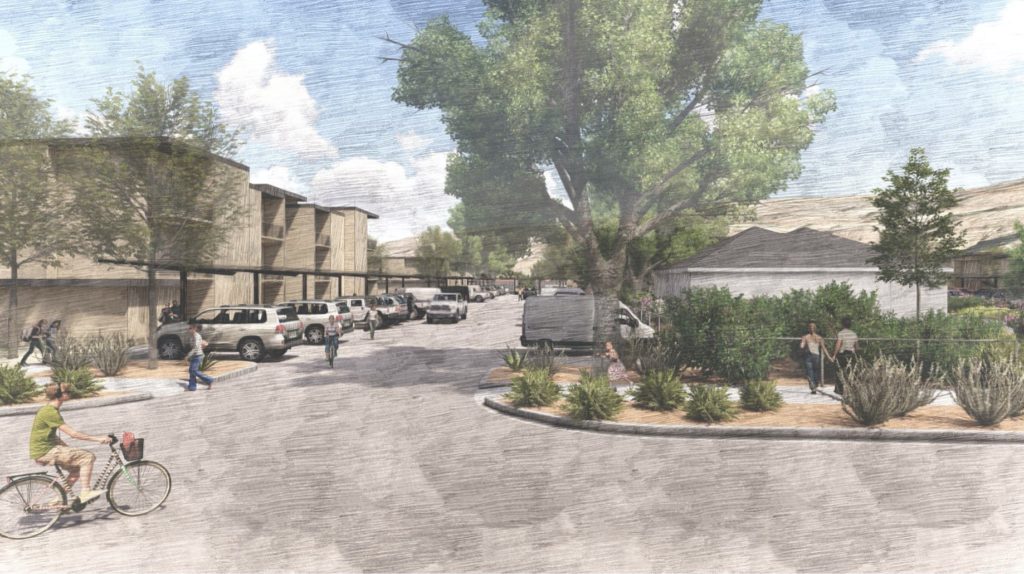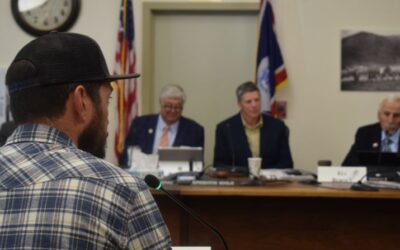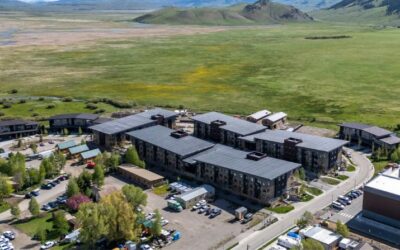Rosa Gonzales is describing her ideal home. Rosa is not her real name. She asked us to change it for this story. But her dreams of a three-bedroom apartment for her and her two teenage sons–those are real.
“My kids live comfortably,” she said. “But they do say that they would like to have a nicer apartment similar to the way other kids live. Right now we live pretty tightly.”
The family lives in a one-bedroom trailer in the Walnut Lane neighborhood, where Gonzales’ 16-year-old sleeps in the living room. And her 19-year-old in the kitchen.
“He has a sofa bed there, and I have my little room that gets wet,” Gonzales said.
Gonzales explained that when it rains, water leaks right down onto her bed. Her prefabricated trailer is well over 50 years old. Maintenance crews have been troubleshooting to fix it. Leaks, as well as issues with plumbing and electrical, are not unusual in Walnut Lane. Thirty-seven of these aging trailers currently house about 85 Moab residents.
“I have heard that they have plans to build some apartments for people who live in Walnut Lane, so we can move into more updated and better housing,” Gonzales said. “We want something better.”
Gonzales’ landlord is Moab City. And they do have plans to bring something better to this community, many of whom make up the backbone of the tourism industry. Gonzales works cleaning hotel rooms. Her neighbors work in restaurants and other service industry jobs. Like her, many are Spanish-speaking immigrants.
“I really do want people to understand that we value our workforce community,” Moab’s mayor pro-tem Tawny Knuteson-Boyd said. “That we value the people that are cleaning the rooms and that are serving our meals and that are teaching our children.”
Knuteson-Boyd spoke in a busy downtown area not far from Walnut Lane. Visible in the distance is a luxury hotel, where construction displaced residents of a different trailer park several years ago. The city’s elected officials didn’t want that to happen again. So, when they learned the Walnut Lane trailer park was for going up sale, they intervened.
“I think there was general consensus that if it was just put on the open market, that certainly another hotelier or someone wanting to build condos for short-term rentals would snap it up,” Knuteson-Boyd said. “And we also knew that if that happened, they would just scrape the trailers that were there. And the people that were living there would find themselves without a home.”
The decision to buy Walnut Lane was celebrated at the time. Applause rang out in the city council chambers when they approved a purchase loan in 2018. Moab’s elected officials were taking a step to safeguard housing for the local workforce.
But they didn’t want to be a landlord of a trailer park. They wanted to develop long-term affordable housing there and not displace any current residents in the process.
“I mean, it’s obviously been a challenge to figure out how and what that looks like,” said Kaitlin Meyers, the senior projects manager for Moab City.
Meyers has spent half a decade working on housing policy in the community. But her main job right now is overseeing the development of what will be the Walnut Lane Apartments.

An illustrated drawing of a concept for the future Walnut Lane Apartments. If built, it would be Moab’s first-ever municipal-developed workforce apartments. (Molly Marcello/KZMU)
“The project will be built out in three phases in order to meet the city’s goal of not displacing any of the current residents,” she said. “So, the first phase will be eight units – it will be four duplex buildings. So, that’s what we’re working on right now. We’ll move in eight of the tenants into those units, remove eight trailers, and then in the place of those trailers we will build a 24-unit apartment building.”
This is the first time Moab City is acting as a developer for its own affordable housing project. They want 80 units of multifamily housing, which would more than double the current density available with the trailer park.
“The fact that the city purchased such a prime piece of land within downtown that will be permanently restricted for people that live and work here–I think that’s huge,” Meyers said.
But general enthusiasm for the project has waned lately. It’s been three years since Moab City purchased the trailer park property. They were finally supposed to break ground on phase one of the apartments this summer, but instead terminated their contract with their builder after the company couldn’t meet the performance bond requirements.
After this setback–and staring down a total project cost of $18 million–some city council members suggested cutting their losses and replacing the old trailers with new ones. Others are still pushing for a longer-term solution. Meyers projects the Moab area will need 700 more units of housing by 2030 across a variety of incomes.
“We do need the density,” she said. “We want an opportunity to provide more housing for residents that need it. And the only way to do that is to build multifamily housing.”
Moab City is under some stress as they actively look for a new builder. They have to meet looming deadlines on a multi-million-dollar sales tax bond. And unlike other towns with a housing crisis in our region, they don’t have a dedicated revenue source for affordable housing development.
“The thing Park City has that Moab City doesn’t have is the money,” Knuteson-Boyd said.
Park City is on its way to have 800 affordable housing units built by 2025. They’ve fed their affordable housing fund a number of ways, including requiring developers pay mitigation fees. Telluride, Colorado, does this too. Telluride’s housing fund is also buffered by special taxes, including one on short-term rentals.
In 2018, Moab’s elected officials passed the Workforce Assured Housing Opportunities Ordinance–or WAHOO. It collected additional fees on new overnight accommodations, to be spent on affordable housing. Meyers said they have about $1.5 million in that fund. But that’s all there will be–shortly after elected officials enacted WAHOO, they placed a moratorium on new overnight accommodations.
“We received applications for hotels, and then the city put a moratorium and then eventually removed overnight accommodations,” she said. “We kind of shut off that funding source for ourselves. So, it’s a blessing and a curse.”
Moab’s city council is working to get new workforce housing requirements in place. It’s unclear when they’ll be enacted or eventually see a payoff. If they do commit to another affordable housing project in the future, Knuteson-Boyd said she wants to explore public-private partnerships. That way, the private sector can shoulder some of the financial and logistical burden of development. For now, she said it’s important to stay focused and ensure multifamily housing at Walnut Lane just gets done.
“I feel like it really is a necessary project for a couple of reasons,” she said. “To prove that it can be done. To prove that quality housing can be built, and it can remain affordable, and it can serve those in our community that need it the most.”
Back at Walnut Lane, Gonzales said she’s looked for other places for her family to live in Moab, but there’s nothing available right now at a price she can afford.
“I have tried looking for housing in other places, but I can’t find anything,” she said.
Moab City is hoping to get a new builder in place by the end of the year and to break ground on phase one next summer. So, Gonzales said she’ll stay put for now, and wait for the new apartments.
“I hope they build them one day,” she said. “I have been hearing about the project for so long that I don’t believe it’s real. But I have faith in God that they will build and that I will benefit from them because my kids and myself need them. And so I stop getting wet in my bedroom.”
This story is part of a collaboration between the Solutions Journalism Network and Rocky Mountain Community Radio highlighting affordable housing solutions across the Mountain West.
Mónica Piñera conducted the interview with Rosa and Rachell Nethercut of the Moab Valley Multicultural Center provided the translation. For more on the multicultural center, visit mvmc.org.





